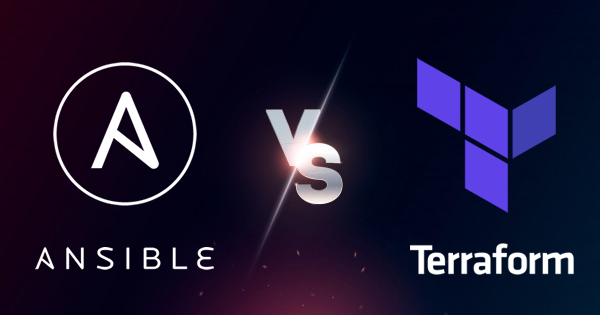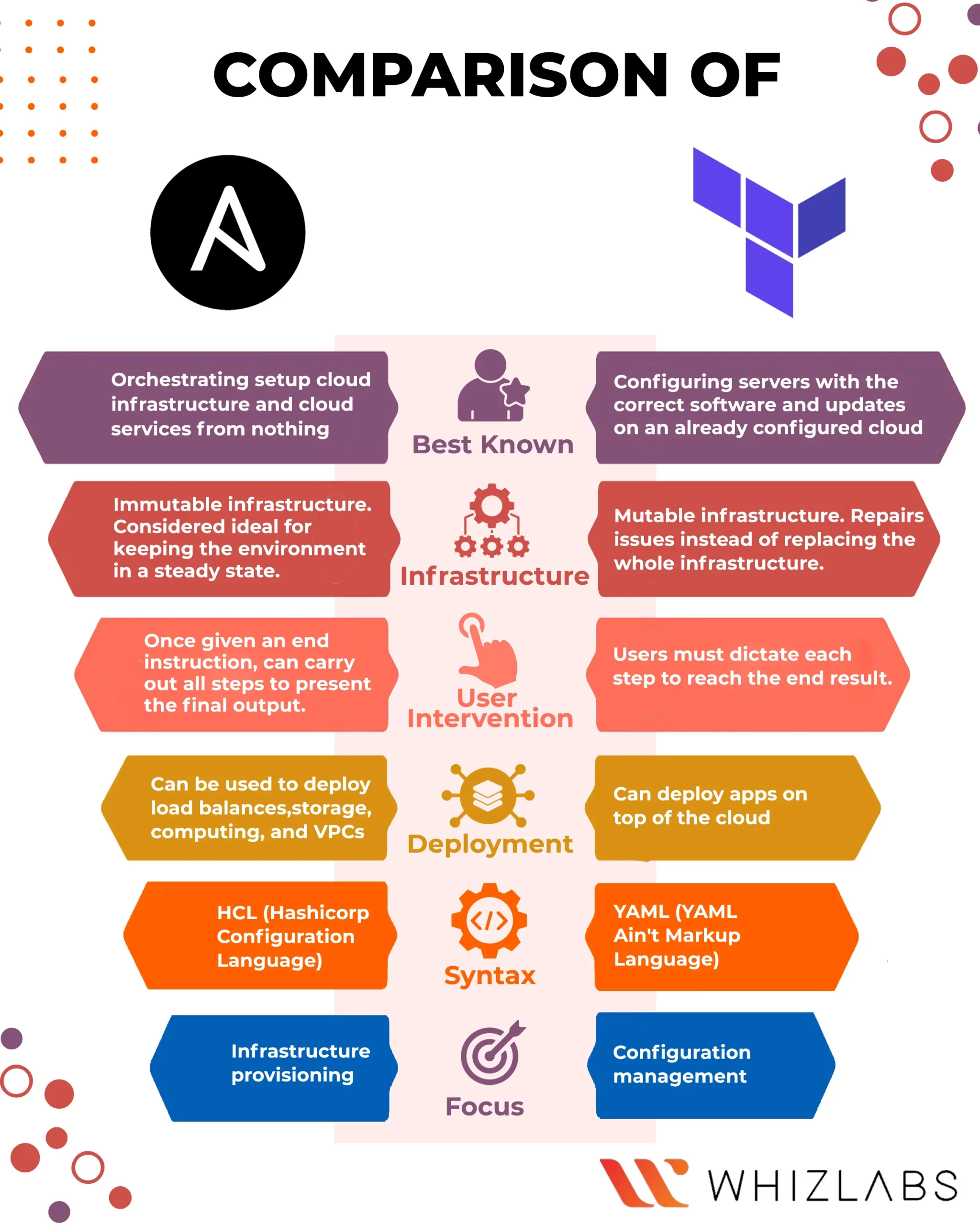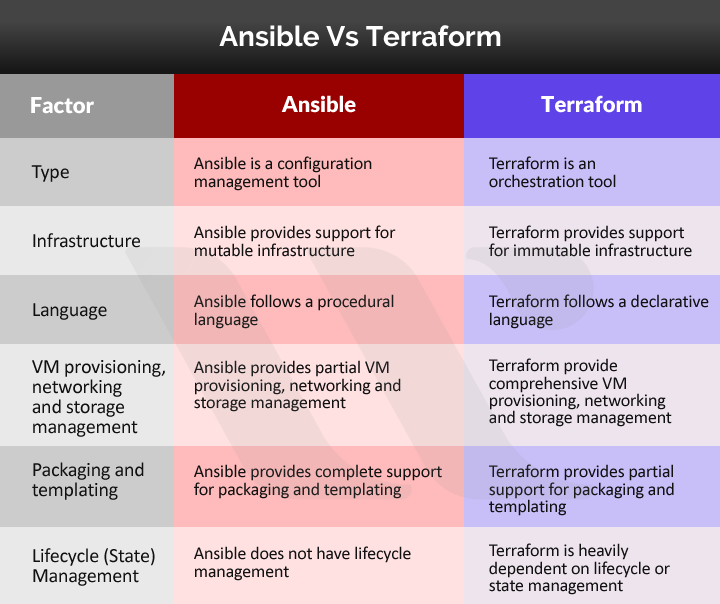The Ansible vs Terraform battle continues to escalate with every passing day as the DevOps movement gains momentum. These two names are prominent in the DevOps landscape now, and you can hear them frequently from time to time. Each tool is known for its distinct advantages in creating infrastructure as code (IAC).
They both can provide IAC that can help in deploying repeatable environments dealing with various complexity requirements. However, many individuals are not aware of the difference between Ansible and Terraform. It can be easy to choose from one popular alternative when it comes to DevOps. Due to the huge demand for Ansible professionals, DevOps professionals are more intended to get an Ansible certification.
On the other hand, what can you do when both these tools have comprehensive advantages? The following discussion aims to provide clear definitions of Ansible and Terraform and an outline of the differences between them. The interesting part of this discussion lies in finding out the specific applications for which they are suitable.
Understanding the Terms: Ansible and Terraform
Almost every organization and startup in technology looks for solutions to automate apps and their IT infrastructure. With the raging debate around Ansible vs Terraform, it is inevitable to find out the best tools. However, the problem is that we are looking for the best tool among these two for automation in the general sense.
A closer evaluation of the differences between them, along with a comprehensive impression of each tool, can help us. The primary objective should be to find out the ideal applications of Terraform and Ansible. As a result, you can be able to find ways to get the best from each tool. So, let us outline their definitions before moving towards a comparison between the two IAC tools.
Also Check: Chef vs Puppet
What is Ansible?
When looking for results of Ansible vs Terraform, you will find that Ansible is a simple tool for automation. It is an open-source tool with declarative language. Ansible is ideal for software provisioning, application deployment, and configuration management. The prominent advantage of Ansible is evident in the reduction of complexity and speeding up DevOps initiatives.
Ansible is also capable of better orchestration for complex IT tasks such as zero downtime rolling updates and continuous deployments. The primary objectives of Ansible are simplicity and higher ease of use.
Let’s go through the Ansible tutorial to understand it better!
What is Terraform?
The other participant in the battle of Ansible vs Terraform receives support from Red Hat. It is presently administered as a tool on AWS for orchestration. Terraform includes Packer for addressing the automation tasks. You can assume Terraform as an infrastructure provisioning tool that communicates with VMware, AWS, GCP, and ensures infrastructure deployment.
Terraform comes from the house of HashiCorp and is ideal for creating, managing, and improving infrastructure. It involves an open-source code responsible for pushing APIs into configuration files. Terraform appears to be a strong contender in the battle of Terraform Vs. Ansible due to some unique advantages.
For instance, terraform can allow the description of your total infrastructure as code irrespective of the number of service providers. You can have servers from AWS, database from Heroku, and DNS from Cloudflare. In this case, terraform helps in building all these resources in parallel across all service providers. So, if you are aspiring to build a successful career in Terraform, you should get a Terraform certification and take your career one level up.
Differences between Ansible and Terraform – Ansible vs Terraform
Now, both the players in the battle of Terraform Vs. Ansible has placed their cards on the table. Let us find out who wins by evaluating the pros and cons of each tool.
-
Orchestration or Configuration Management
The foremost point of comparison in Ansible vs Terraform arises in terms of their applications. The basic thing that you should keep in mind that both these tools are similar applications, although with some differences. The difference between these tools involves prominent association with two crucial DevOps concepts, i.e., orchestration and configuration management.
These terms are ideal for describing the functions of certain tools, and so the same applies in the case of these tools. Ansible is a configuration management tool. Terraform is a tool for orchestration. Despite the overlap between the functionalities of configuration management and orchestration, the differences are crucial. A clear understanding of the differences between these tools can help in finding the right applications according to their strengths.
You can understand this aspect of the Ansible vs Terraform battle by reflecting on a practical example. Assume that both these tools are a part of an orchestra of musicians. An orchestration tool like Terraform serves as the manager or the conductor of the orchestra. The conductor is responsible for ensuring that the right number of instruments are in place.
In addition, the conductor also ensures that all the instruments are playing correctly. If any instrument malfunctions, then the conductor can remove the instrument and replace it with a well-functioning instrument. So, we can note that orchestration tools like Terraform focus highly on the final objectives. Therefore, Terraform always emphasizes on maintaining a particular state of the environment.
Also Read: Ansible Tutorial – How Ansible Works?
Terraform stores the desired state of the environment, thereby providing a better foundation for disaster recovery. So, if any disparity occurs, then Terraform can provide the resource automatically upon running it again. Therefore, people wondering about “Why Terraform” should know that it is the ideal instrument for maintaining steady-state environments. All you need to do is go for “Terraform Apply” whenever you encounter an issue with the state of the environment.
Continuing ahead from the practical example situation, let us focus on Ansible in this Ansible vs Terraform battle. As we know, Ansible is a configuration management tool. The role of a configuration management tool is similar to the technician for repairing instruments in an orchestra.
Therefore, a configuration management tool like Ansible is responsible for maintaining all components of an environment in working condition. It has to ensure that every instrument is on key, works properly, and does not have any damage. In the actual scenario, Ansible works in its role as a configuration management tool by repairing issues rather than replacing the whole infrastructure.
Interestingly, Ansible also has certain capabilities for orchestration tasks. This is a prominent reason to consider it as a hybrid. However, the role of Ansible is primarily better as a configuration management tool. Terraform, on the other hand, has superior state management capabilities that are its forte. Therefore, the difference between the two IAC tools is prominently evident in their DevOps functionalities of configuration management and orchestration.
-
Procedural or Declarative
The best comparison between the two tools under concern for this discussion is possible by looking at the way of their working. Before pondering over “Why Ansible”, let us dive deeper into the differences with Terraform based on procedural or declarative processes. Many DevOps tools are classified into procedural and declarative categories.
However, the definition of procedural and declarative categories is very brief, and many tools fulfill the requirements of both. The procedural category implies applications that need the exact steps presented in the code. For example, if you want to scale up the EC2 instances, then you need to specify the number of instances.
Similarly, if you want to scale down the EC2 instances, then you have to specify the number of instances to remove. We can assume the orchestra scenario again for a better understanding. The procedural category involves a tool that is like a conductor demanding 5 guitars only to get five more guitars.
Declarative tools generally provide an exact impression of the requirements irrespective of the process used for accomplishing desired results. In this case, you find a conductor needing 5 guitars again in the orchestra and having the same number of guitars after a performance. In the real scenario, if you need 5 EC2 instances for scaling up your environment, then specify the exact amount.
Now we know about procedural and declarative categories clearly and the nature of tools in these categories. What does this imply? You can notice that Terraform fulfills the criteria for declarative. With Terraform, you have to define the environment specifically, and “Terraform Apply” can help in correcting any changes in the environment. So, why, Ansible? Ansible is actually a hybrid of procedural and declarative. You could perform ad-hoc commands for procedural-style configuration.
On the other hand, you have the option of using various Ansible modules that can perform declarative-style configuration. Therefore, the Ansible best practices indicate a complete review of Ansible documentation for any particular role. As a result, you could know when to indicate resources explicitly and when to add or subtract resources for desired results.
You can take a look at the summary of differences in Ansible vs Terraform here –
Preparing for an Ansible interview? Go through these top Ansible interview questions and get ready to crack the Ansible interview.
Final Words
The possibility of a perfect answer on “Why Terraform” or “Why not Ansible” depends largely on your requirements. Both the tools have many similarities and a fair share of differences as well. So, which one is the best? From a practical perspective, it is advisable to use Ansible for configuration management and Terraform for orchestration. The primary purpose of Terraform is orchestration, and it is considerably intuitive.
You can find that all updates on Terraform are ideal for orchestration. Also, the “Terraform Plan” can help in obtaining more useful information as compared to the “Ansible –dry-run” command. On the other hand, Ansible is your ideal tool for configuration management. However, you should also note the limitations of Ansible in orchestration tasks.
If you are new to Ansible and want to learn, enroll in our Ansible basics training course and learn to automate the deployment, configuration, and management of your infrastructure.
- Top 10 Highest Paying Cloud Certifications in 2024 - March 1, 2023
- 12 AWS Certifications – Which One Should I Choose? - February 22, 2023
- 11 Kubernetes Security Best Practices you should follow in 2024 - May 30, 2022
- How to run Kubernetes on AWS – A detailed Guide! - May 30, 2022
- Free questions on CompTIA Network+ (N10-008) Certification Exam - April 13, 2022
- 30 Free Questions on Microsoft Azure AI Fundamentals (AI-900) - March 25, 2022
- How to Integrate Jenkins with GitHub? - March 22, 2022
- How to Create CI/CD Pipeline Inside Jenkins ? - March 22, 2022






you need to change the symbols on top of the first summary of differences between terraform and ansible please.